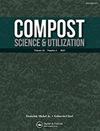污泥堆肥对萝卜吸收铅和铜的影响
IF 0.9
4区 农林科学
Q3 ECOLOGY
引用次数: 1
摘要
通过应用堆肥废水污泥(CWS)增加金属浓度的潜在风险受到关注。特别是,堆肥废水污泥对铅等金属的高亲和力可能会影响植物对金属的吸收程度。在本研究中,采用顺序萃取法测定了CWS中Pb、Cu、Cr、Cd、Zn、Ni和Fe的分离和生物利用度。为了评价水煤浆对金属吸收的影响,以快速生长的萝卜Raphanus sativus L.(栽培萝卜)为研究对象,在添加了Pb和Cu的4种不同成分(0、25、50、75、100% w/w)珍珠岩的水煤浆中生长。3周后收获植株,分析Pb和Cu浓度。还评估了在pH 7.3和5.8下施用时金属的吸收程度以及Cu和Pb之间的相互竞争。在25% ~ 50% (w/w) CWS配比下,植株生长最佳,pH升高可降低植株组织中Pb和Cu的浓度。根中金属含量高于-à-vis茎或叶。研究发现,以无机形式提供的金属盐需要3周以上的较长潜伏期才能被纳入水煤浆结构并减少它们的吸收。本文章由计算机程序翻译,如有差异,请以英文原文为准。
Influence of Composted Wastewater Sludge (CWS) on Lead and Copper Uptake by Radish (Raphanus sativus L.)
Abstract The potential risk of increased metal concentrations through the application of composted wastewater sludge (CWS) is of concern. In particular, the high affinity of composted wastewater sludge for metals such as Pb, may influence the extent of metal uptake by plants. In this study, a sequential extraction protocol was employed to determine the fractionation and bioavailability of Pb, Cu, Cr, Cd, Zn, Ni, and Fe in CWS. To evaluate the influence of CWS on metal uptake, a fast growing plant Raphanus sativus L. (cultivated radish), was grown in CWS amended with perlite at four different compositions (0, 25, 50, 75, 100% w/w) treated with Pb and Cu. Plants were harvested after 3 weeks and analyzed for Pb and Cu concentrations. The extent of metal uptake, and intercompetitions between Cu and Pb upon application, at pH 7.3 and 5.8 was also assessed. Best growth was apparent at 25% to 50% (w/w) CWS composition, while an increase in the pH lowered Pb and Cu concentrations in plant tissues. Higher metal concentrations were found in roots vis-à-vis shoot or leaves. In was found that longer incubation periods of more than 3 weeks are needed for metal salts supplied in the inorganic form to be incorporated into the CWS structure and reduce their uptake.
求助全文
通过发布文献求助,成功后即可免费获取论文全文。
去求助
来源期刊

Compost Science & Utilization
农林科学-生态学
CiteScore
4.10
自引率
0.00%
发文量
0
审稿时长
>36 weeks
期刊介绍:
4 issues per year
Compost Science & Utilization is currently abstracted/indexed in: CABI Agriculture & Environment Abstracts, CSA Biotechnology and Environmental Engineering Abstracts, EBSCOhost Abstracts, Elsevier Compendex and GEOBASE Abstracts, PubMed, ProQuest Science Abstracts, and Thomson Reuters Biological Abstracts and Science Citation Index
 求助内容:
求助内容: 应助结果提醒方式:
应助结果提醒方式:


